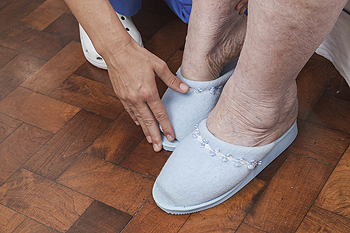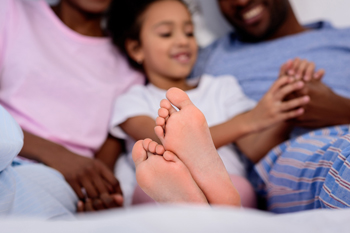
Signs Your Child May Have an Ingrown Toenail
An ingrown toenail is defined as the nail on the big toe growing into the surrounding skin. Parents may notice their child is limping as this condition develops. In severe cases, it can cause difficulty walking, and may be beneficial to seek immediate treatment. Ingrown toenails can cause severe pain and discomfort, and often occur due to wearing shoes that do not have adequate room for the toes to move freely. Additionally, genetic factors may contribute to the onset of an ingrown toenail. The symptoms patients can experience can include redness, swelling, extreme tenderness, and a yellow discharge oozing from the affected area. If you notice your child has any of these symptoms, it is strongly suggested that you consult with a podiatrist who can effectively treat ingrown toenails.
Ingrown toenails may initially present themselves as a minor discomfort, but they may progress into an infection in the skin without proper treatment. For more information about ingrown toenails, contact Milos Tomich, DPM of Dr. Tomich Foot & Ankle Health Center. Our doctor can provide the care you need to keep you pain-free and on your feet.
Ingrown Toenails
Ingrown toenails are caused when the corner or side of a toenail grows into the soft flesh surrounding it. They often result in redness, swelling, pain, and in some cases, infection. This condition typically affects the big toe and may recur if it is not treated properly.
Causes
- Improper toenail trimming
- Genetics
- Improper shoe fitting
- Injury from pedicures or nail picking
- Abnormal gait
- Poor hygiene
You are more likely to develop an ingrown toenail if you are obese, have diabetes, arthritis, or have any fungal infection in your nails. Additionally, people who have foot or toe deformities are at a higher risk of developing an ingrown toenail.
Symptoms
Some symptoms of ingrown toenails are redness, swelling, and pain. In rare cases, there may be a yellowish drainage coming from the nail.
Treatment
Ignoring an ingrown toenail can have serious complications. Infections of the nail border can progress to a deeper soft-tissue infection, which can then turn into a bone infection. You should always speak with your podiatrist if you suspect you have an ingrown toenail, especially if you have diabetes or poor circulation.
If you have any questions, please feel free to contact one of our offices located in Milwaukee and Wauwatosa, WI . We offer the newest diagnostic and treatment technologies for all your foot care needs.
Ingrown Toenails
Ingrown toenails (onychocryptosis) are a common foot ailment and it is very unpleasant to experience. The condition is caused by an increase in pressure from the ingrowth of the nail edge into the skin of the toe. Ingrown toenails commonly cause pain in those who experience them. In some cases, the skin surrounding the ingrown toenail may break which may lead bacteria to enter through and cause an infection. Common symptoms of this ailment include pain, redness, swelling, and warmth around the toe.
An imbalance between the size of the nail and the enlargement of the nail skin edge causes ingrown toenails. This condition is often caused by improperly trimming the toenails. If you are trying you cut your nails, you should always try to trim straight across instead of in a rounded shape. Ingrown toenails can also be an inherited condition and they may also be caused by improper shoe fitting.
Another common cause of the condition is wearing shoes that are either too small or too large. Other causes include poor foot hygiene, obesity, diabetes, arthritis, edema, and fungal infections. There are many risk factors that may make a person more likely to develop an ingrown toenail. Athletes who play “stop and start” sports such as tennis, soccer, and basketball are most likely to have ingrown toenails.
People who have diabetes, a compromised immune system, or poor circulation should immediately seek care from a podiatrist if they have an ingrown toenail. It is also recommended to seek professional assistance if at-home remedies are not successful within a week or if there is persistent pain.
Diabetic Feet Need Frequent Exams
 Diabetic feet are prone to developing infections and foot ulcers. This is generally a result of the inability to feel cuts or bruises that may develop on the feet. This is caused by elevated insulin levels in the blood that can come from obesity and eating unhealthy foods. It is important to maintain proper foot care by trimming the toenails correctly, and keeping the feet clean and moisturized. Checking the feet daily may help to notice any discoloration that can accompany diabetes, in addition to abnormal swelling. If you have diabetes, it is strongly suggested that you speak with a podiatrist on a frequent basis, and have routine foot examinations performed.
Diabetic feet are prone to developing infections and foot ulcers. This is generally a result of the inability to feel cuts or bruises that may develop on the feet. This is caused by elevated insulin levels in the blood that can come from obesity and eating unhealthy foods. It is important to maintain proper foot care by trimming the toenails correctly, and keeping the feet clean and moisturized. Checking the feet daily may help to notice any discoloration that can accompany diabetes, in addition to abnormal swelling. If you have diabetes, it is strongly suggested that you speak with a podiatrist on a frequent basis, and have routine foot examinations performed.
Diabetic foot care is important in preventing foot ailments such as ulcers. If you are suffering from diabetes or have any other concerns about your feet, contact Milos Tomich, DPM from Dr. Tomich Foot & Ankle Health Center. Our doctor can provide the care you need to keep you pain-free and on your feet.
Diabetic Foot Care
Diabetes affects millions of people every year. The condition can damage blood vessels in many parts of the body, especially the feet. Because of this, taking care of your feet is essential if you have diabetes, and having a podiatrist help monitor your foot health is highly recommended.
The Importance of Caring for Your Feet
- Routinely inspect your feet for bruises or sores.
- Wear socks that fit your feet comfortably.
- Wear comfortable shoes that provide adequate support.
Patients with diabetes should have their doctor monitor their blood levels, as blood sugar levels play such a huge role in diabetic care. Monitoring these levels on a regular basis is highly advised.
It is always best to inform your healthcare professional of any concerns you may have regarding your feet, especially for diabetic patients. Early treatment and routine foot examinations are keys to maintaining proper health, especially because severe complications can arise if proper treatment is not applied.
If you have any questions please feel free to contact one of our offices located in Milwaukee and Wauwatosa, WI . We offer the newest diagnostic and treatment technologies for all your foot and ankle needs.
Diabetic Foot Conditions
According to the American Diabetes Association (ADA), diabetes is a condition that affects approximately 23.6 million Americans. Around 750,000 new cases are diagnosed each year, and the disease’s most common form, Type 2 diabetes, makes up for 90 to 95 percent of these cases. Type 2 diabetes is especially prevalent among older Americans, those who are obese, and those who lead sedentary lifestyles.
Complications of the disease may lead to several foot and ankle-related conditions. The loss of nerve sensation, or neuropathy, can cause diabetics to lose feeling at the bottom of the feet and therefore leave them unaware of pain, pressure, and heat. Decreased circulation is another complication of diabetes that can slow down the healing of wounds and injuries; this can lead to the development of foot ulcers.
To prevent foot ulcers from forming, diabetics should examine their feet every day for small cuts and wear shoes that curtail pressure. Constant monitoring for the risk factors associated with ulcer formation can allow for early detection and therefore lessen the possibility of ulcers or, even worse, amputation. The removal of calluses and ingrown toenails should be left to the podiatrist to avoid improper removal and possible infection.
Diabetic patients may also experience foot deformities due to complications in their feet, such as limited joint mobility, muscle atrophy, and decreased fat padding. These complications can increase pressure in certain areas of the foot, which in turn can cause certain deformities, such as hammertoe, to form. Another deformity, Charcot foot, develops due to the collapsing of microfractures in the bones of the feet. The resulting deformity is a foot that is flattened and wider in appearance.
To help minimize pressure and prevent the development of these diabetes-related foot and ankle conditions, your podiatrist may consider using orthotics or special shoes. Charcot foot may be treated using walkers, custom orthotic insoles, or non-weight-bearing or rigid weight-bearing casts or braces. In more serious cases, surgery may be considered to treat more developed deformities. Ulcers can be further cared for with the help of proper diet, medication to control glucose, intensive wound care, and infection treatment.
Heel Spurs and The Plantar Fascia
 The human foot has twenty-six bones. A heel spur is defined as a bony hook that forms on the bottom of the heel. This often causes severe pain and discomfort, and it can be difficult to walk. Heel spurs form on the largest bone in the foot, known as the calcaneus. The heel spur generally develops at the spot where the plantar fascia attaches to the bone. This band of tissue is located on the sole of the foot, and connects the heel to the toes. The pain comes from surrounding tissues that become inflamed, and sharp and sudden pain may exist in the sole of the foot. Heel spurs can be diagnosed by taking an X-ray of the affected foot. If you have a heel spur, it is strongly suggested that you seek the counsel of a podiatrist who can effectively diagnose and treat heel spurs.
The human foot has twenty-six bones. A heel spur is defined as a bony hook that forms on the bottom of the heel. This often causes severe pain and discomfort, and it can be difficult to walk. Heel spurs form on the largest bone in the foot, known as the calcaneus. The heel spur generally develops at the spot where the plantar fascia attaches to the bone. This band of tissue is located on the sole of the foot, and connects the heel to the toes. The pain comes from surrounding tissues that become inflamed, and sharp and sudden pain may exist in the sole of the foot. Heel spurs can be diagnosed by taking an X-ray of the affected foot. If you have a heel spur, it is strongly suggested that you seek the counsel of a podiatrist who can effectively diagnose and treat heel spurs.
Heel spurs can be incredibly painful and sometimes may make you unable to participate in physical activities. To get medical care for your heel spurs, contact Milos Tomich, DPM from Dr. Tomich Foot & Ankle Health Center. Our doctor will do everything possible to treat your condition.
Heels Spurs
Heel spurs are formed by calcium deposits on the back of the foot where the heel is. This can also be caused by small fragments of bone breaking off one section of the foot, attaching onto the back of the foot. Heel spurs can also be bone growth on the back of the foot and may grow in the direction of the arch of the foot.
Older individuals usually suffer from heel spurs and pain sometimes intensifies with age. One of the main condition's spurs are related to is plantar fasciitis.
Pain
The pain associated with spurs is often because of weight placed on the feet. When someone is walking, their entire weight is concentrated on the feet. Bone spurs then have the tendency to affect other bones and tissues around the foot. As the pain continues, the feet will become tender and sensitive over time.
Treatments
There are many ways to treat heel spurs. If one is suffering from heel spurs in conjunction with pain, there are several methods for healing. Medication, surgery, and herbal care are some options.
If you have any questions feel free to contact one of our offices located in Milwaukee and Wauwatosa, WI . We offer the latest in diagnostic and treatment technology to meet your needs.
How to Treat Heel Spurs
Heel spurs are calcium deposits that cause bone protrusions on the heel bone. Heel spurs are usually associated with plantar fasciitis, which occurs when the plantar fasciitis in the foot becomes inflamed. Typically, heel spurs don’t cause any symptoms. However, they can produce chronic or intermittent heel pain. Those who have had the condition often describe the irritation as a stabbing pain.
There are risk factors that may make you more likely to develop heel spurs. People who have abnormal walking gaits, run and jog on hard surfaces, are obese, or wear poorly fitting shoes are more likely to develop heel spurs.
Fortunately, there are precautions you can take to avoid developing heel spurs. One of the best ways to do this is by wearing well-fitting shoes with shock-absorbent soles. Another preventative technique is to choose running shoes if you plan on running, and walking shoes if you plan on walking. Shoes are made for different activities and it is important to research a shoe before you purchase a pair.
The pain associated with heel spurs often decreases the more you walk. However, a recurrence of pain after an extended period of rest or walking is likely to occur with this condition. Those with severe heel spur pain may opt to go the surgical route for treatment. However, more than 90% of those with the condition get better without surgical treatment. If you have a heel spur and want to know if surgery is right for you, you should go to your podiatrist and he or she will be able to conduct a pre-surgical test or exam to determine if you are an optimal candidate for surgery.
Winter Wound Care Prevention
 Foot wound prevention and care can be slightly more difficult during the cold winter season than during the rest of the year. A common cause of foot wounds in the wintertime is, perhaps ironically, excessive heat. When trying to warm up during the winter, you may not notice excess heat from a hot bath or space heater potentially burning your feet, especially if you have reduced sensation due to conditions like diabetes. Another culprit of foot wounds in the wintertime is dry skin. The cold winter air can make the skin of the feet dry and more likely to crack, thereby increasing the risk of developing foot wounds. It is important to monitor the health of your feet in the winter and all year round, checking regularly for any cuts, scrapes, sores, or other abnormalities. If you notice any changes in your feet, please consult with a podiatrist.
Foot wound prevention and care can be slightly more difficult during the cold winter season than during the rest of the year. A common cause of foot wounds in the wintertime is, perhaps ironically, excessive heat. When trying to warm up during the winter, you may not notice excess heat from a hot bath or space heater potentially burning your feet, especially if you have reduced sensation due to conditions like diabetes. Another culprit of foot wounds in the wintertime is dry skin. The cold winter air can make the skin of the feet dry and more likely to crack, thereby increasing the risk of developing foot wounds. It is important to monitor the health of your feet in the winter and all year round, checking regularly for any cuts, scrapes, sores, or other abnormalities. If you notice any changes in your feet, please consult with a podiatrist.
Wound care is an important part in dealing with diabetes. If you have diabetes and a foot wound or would like more information about wound care for diabetics, consult with Milos Tomich, DPM from Dr. Tomich Foot & Ankle Health Center. Our doctor will assess your condition and provide you with quality foot and ankle treatment.
What Is Wound Care?
Wound care is the practice of taking proper care of a wound. This can range from the smallest to the largest of wounds. While everyone can benefit from proper wound care, it is much more important for diabetics. Diabetics often suffer from poor blood circulation which causes wounds to heal much slower than they would in a non-diabetic.
What Is the Importance of Wound Care?
While it may not seem apparent with small ulcers on the foot, for diabetics, any size ulcer can become infected. Diabetics often also suffer from neuropathy, or nerve loss. This means they might not even feel when they have an ulcer on their foot. If the wound becomes severely infected, amputation may be necessary. Therefore, it is of the upmost importance to properly care for any and all foot wounds.
How to Care for Wounds
The best way to care for foot wounds is to prevent them. For diabetics, this means daily inspections of the feet for any signs of abnormalities or ulcers. It is also recommended to see a podiatrist several times a year for a foot inspection. If you do have an ulcer, run the wound under water to clear dirt from the wound; then apply antibiotic ointment to the wound and cover with a bandage. Bandages should be changed daily and keeping pressure off the wound is smart. It is advised to see a podiatrist, who can keep an eye on it.
If you have any questions, please feel free to contact one of our offices located in Milwaukee and Wauwatosa, WI . We offer the newest diagnostic and treatment technologies for all your foot care needs.
Wound Care
Diabetics must be wary of all wounds, regardless of depth or size. Diabetes, a chronic disease in which the body cannot properly use glucose the way it normally would, causes various complications that make wounds difficult to heal. Nerve damage or neuropathy will cause diabetics to have trouble feeling the pain of a blister or cut until the condition has significantly worsened or become infected. A diabetic’s weakened immune system can make even the most minor of wounds easily susceptible to infection. Diabetics are also more prone to developing narrow, clogged arteries, and are therefore more likely to develop wounds.
Wounds should be taken care of immediately after discovery, as even the smallest of wounds can become infected if enough bacteria build up within the wound. To remove dirt, wounds should be first rinsed under running water only. Soap, hydrogen peroxide, or iodine can irritate the injury and should be avoided. To prevent infection, apply antibiotic ointment to the wound and cover it with a bandage. The bandage should be changed daily. The skin around the wound may be cleaned with soap.
To prevent further exacerbation, see a doctor—especially if you have diabetes. Minor skin conditions can become larger problems if not properly inspected. As the wound heals, make sure to avoid applying pressure to the affected area.
Techniques That May Help to Prevent Falling
 Falling episodes among elderly people is a common occurrence worldwide. Many patients' feet are affected, and may endure a broken foot or sprained ankle as a result of an unexpected fall. Effective prevention techniques can consist of improving lighting in the household and getting regular physical examinations. Maintaining correct medications which may affect your vision can also reduce the risk of falling. Additionally, many patients find it is beneficial to install grab bars in the shower and toilet area, as this provides the necessary stability that can help to prevent falling. If you or a loved one is concerned about how falling can affect the feet, it is suggested that you speak with a podiatrist who can help you with proper prevention techniques.
Falling episodes among elderly people is a common occurrence worldwide. Many patients' feet are affected, and may endure a broken foot or sprained ankle as a result of an unexpected fall. Effective prevention techniques can consist of improving lighting in the household and getting regular physical examinations. Maintaining correct medications which may affect your vision can also reduce the risk of falling. Additionally, many patients find it is beneficial to install grab bars in the shower and toilet area, as this provides the necessary stability that can help to prevent falling. If you or a loved one is concerned about how falling can affect the feet, it is suggested that you speak with a podiatrist who can help you with proper prevention techniques.
Preventing falls among the elderly is very important. If you are older and have fallen or fear that you are prone to falling, consult with Milos Tomich, DPM from Dr. Tomich Foot & Ankle Health Center. Our doctor will assess your condition and provide you with quality advice and care.
Every 11 seconds, an elderly American is being treated in an emergency room for a fall related injury. Falls are the leading cause of head and hip injuries for those 65 and older. Due to decreases in strength, balance, senses, and lack of awareness, elderly persons are very susceptible to falling. Thankfully, there are a number of things older persons can do to prevent falls.
How to Prevent Falls
Some effective methods that older persons can do to prevent falls include:
- Enrolling in strength and balance exercise program to increase balance and strength
- Periodically having your sight and hearing checked
- Discuss any medications you have with a doctor to see if it increases the risk of falling
- Clearing the house of falling hazards and installing devices like grab bars and railings
- Utilizing a walker or cane
- Wearing shoes that provide good support and cushioning
- Talking to family members about falling and increasing awareness
Falling can be a traumatic and embarrassing experience for elderly persons; this can make them less willing to leave the house, and less willing to talk to someone about their fears of falling. Doing such things, however, will increase the likelihood of tripping or losing one’s balance. Knowing the causes of falling and how to prevent them is the best way to mitigate the risk of serious injury.
If you have any questions, please feel free to contact one of our offices located in Milwaukee and Wauwatosa, WI . We offer the newest diagnostic and treatment technologies for all your foot care needs.












